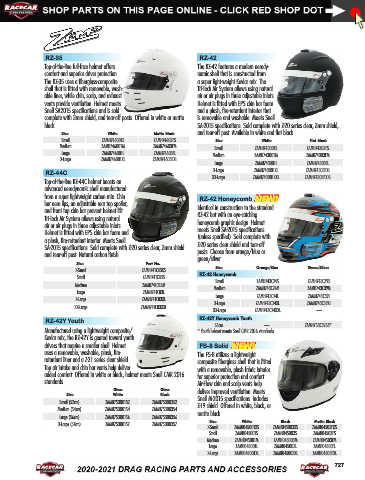Page 732 - 2020-2021 Racecar Engineering Drag Racing Parts and Accessories Catalog
P. 732
2020 DRAG RACING
Spark Plug Heat Range/Cross Reference
Thread Heat Standard Non-Resistor Spark Plugs Power/Projected Tip Non-Resistor Spark Plugs
Size/Reach Hex Range Autolite Champion E3 NGK Accel Autolite Champion E3 NGK
Chevrolet, Chrysler (Wedge), Oldsmobile, Pontiac - Standard Reach - Flat Seat With Gasket
Hot — — — — — — — — NGKR5670-5
— — — NGKB6S — AUTAR73 — — NGKR5670-6
14mm/3/8" 13/16" AUT353 CHPJ4C — NGKB7S — AUTAR72 — — NGKR5670-7
— — — NGKB8S — — — — NGKR5670-8
Cold — — — — — — — — NGKR5670-9
Chevrolet (Big Block), Chrysler (Hemi) - Flat Seat With Gasket
Hot AUTAR3935 CHPC63CX — NGKR5671A-7 — — CHPC63YC — —
AUTAR3934 CHPC61CX E3PE3.103 ‡ NGKR5671A-8 — AUTAR3911 CHPC61YC — NGKR5672A-8
14mm/3/4" 5/8" AUTAR3933† CHPC59CX E3PE3.102 ‡ NGKR5671A-9 — AUTAR3910 † CHPC59YC E3PE3.106 ‡ NGKR5672A-9
AUTAR3932† CHPC57CX E3PE3.101 ‡ NGKR5671A-10 — — CHPC57YC — NGKR5672A-10
Cold AUTAR3931 CHPC55CX — NGKR5671A-11 — — — — —
Chevrolet (Big Block), Chrysler (Hemi) - Flat Seat With Gasket
Hot — — — — — — — — NGKBP5ES
AUTAR2593 — — — — — — — NGKBP6ES
AUTAR2592 — — — — AUTAR53 — — NGKBP7ES
14mm/3/4" 13/16" — — — — — AUTAR52 — — —
— — — — — AUTAR51 — — —
— — — — — AUTAR50 — — —
Cold — — E3PE3.100 ‡ — — — — — —
Chevrolet (Small Block), Ford (Small Block) - Conical/Tapered Seat
Hot — — — — ACL0276S-4* — — — —
— — — NGKR5673-6 — — — — NGKR5674-6
AUTAR135 CHPV63C — NGKR5673-7 — AUTAR13 — — NGKR5674-7
14mm/.460" 5/8" AUTAR134 — E3PE3.105‡ — — AUTAR12 — E3PE3.107 ‡ NGKR5674-8
AUTAR133 CHPV59C E3PE3.104‡ NGKR5673-8 — — — — NGKR5674-9
AUTAR132 CHPV57C — NGKR5673-9 — — — — NGKR5674-10
Cold — — — NGKR5673-10 — — — — —
Chevrolet (Big Block), Ford - Conical/Tapered Seat
Hot — — — — — — CHPRS9YC — —
— — — — — AUTAR94 — — NGKR5724-8
14mm/.708" 5/8" AUTAR474 CHPS59C — — — AUTAR93 CHPS59YC E3PE3.109 ‡ NGKR5724-9
AUTAR473 CHPS57C E3PE3.108 ‡ — — AUTAR92 — — NGKR5724-10
Cold AUTAR472 CHPS55C — — — — — — —
Ford (Windsor and Big Block) - Conical/Tapered Seat
Hot — — — — — AUTAR33 — — —
18mm/.460" 13/16" — — — — — AUTAR32 — — NGKAP8FS
Cold — — — — — — — — —
Important Note: Use cross reference chart as a guide only. Due to differences in design and material, plugs listed in cross reference are not exactly alike.
* “Shorty“ spark plug for added header clearance, sold in 4-pack. ‡ E3 DiamondFIRE fixed gap spark plugs cannot be adjusted.
† Special Autolite Racing "X" style electrode spark plug that alleviates piston/spark plug clearance issues is also available; simply add “X” to end of part number.
TECH TIP
Spark Plug Diagnosis Pictures Courtesy Of Autolite
• Determine the thread diameter, length (reach) and whether tapered or gasket (flat) seat.
• Select gap style.
• Select heat range.
• Adjust fuel mixture and spark advance timing for maximum performance. Normal Fuel Fouled Detonation Oil Fouled
• Inspect plugs and pistons for evidence of detonation, abnormal combustion or excessive temperatures.
• Stay with the same plug type after final heat range selection unless major modifications have been made (increasing the horsepower or operating range).
Spark Plug Heat Range Tech
A spark plug’s Heat Range, defined as the measure of how fast the tip of the plug dissipates combustion heat, can range from as low as 500°F to as high as 2,500°F. Manufacturers offer
plugs in many heat ranges, from cold through medium hot, to very hot. It is imperative that the plug stay cool enough to prevent pre-ignition or electrode destruction, and still remain hot
enough to burn off combustion deposits that form at the firing tip. A plug that is excessively cold or hot for the application in question will eventually cause the engine to misfire. When
working with an engine that is stock or mildly modified, it is often best to use the plug recommended by the car manufacturer. However, if the compression ratio has been altered, a dif-
ferent heat range plug may be required. Many racers rely upon their engine builder for plug heat range recommendations. If a racer is unsure of the correct heat range to use, it is always
recommended to “stay on the safe side” and use a colder plug. A switch in heat range can change the temperature of the spark plug tip by 70-120°F. If the plug selected is too cold, it will
eventually foul and misfire, but it will not damage the engine. A plug which is too hot can cause pre-ignition and detonation, often resulting in a severely damaged engine.
730

